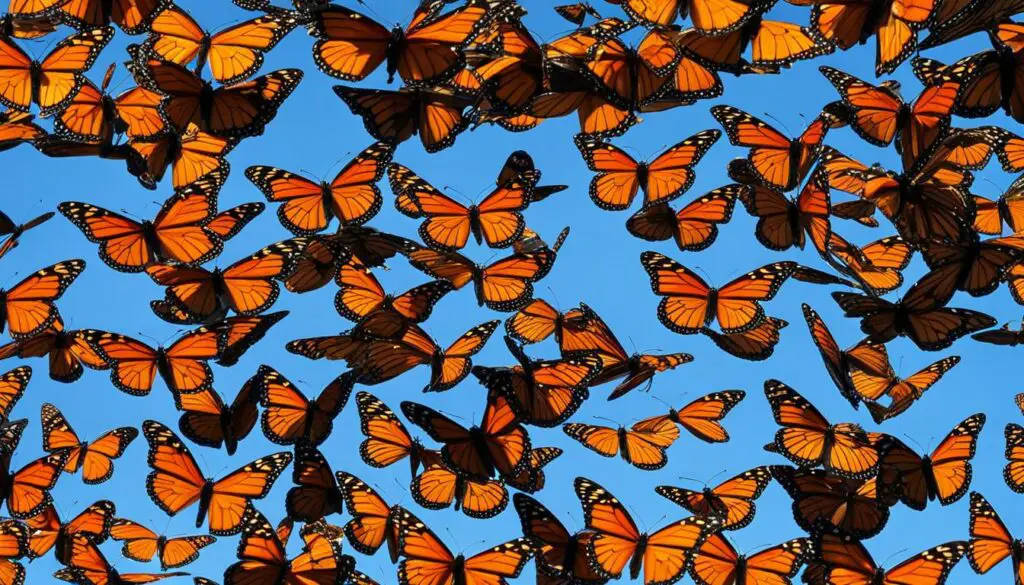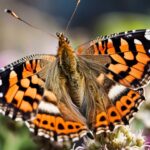The migration of Monarch butterflies is a remarkable phenomenon. Tens of millions of monarch butterflies in North America embark on a journey each winter to central Mexico. This migration is unmatched in the insect world and is more similar to bird migrations. The journey covers distances of up to 4,500 km each way, but what sets it apart is that it takes multiple generations of butterflies to complete the migration. Each generation flies, mates, lays eggs, and dies, passing the baton to the next generation. This leap-frog journey allows monarch butterflies to reach their winter destination despite their short lifespan of only 2 to 6 weeks.
Key Takeaways:
- Monarch butterflies migrate from North America to central Mexico each winter.
- Multiple generations of butterflies are involved in the migration.
- The journey covers distances of up to 4,500 km each way.
- Monarch butterflies have a lifespan of only 2 to 6 weeks.
- Their migration is a unique marvel in the natural world.
Monarch Butterfly Migration Routes and Distances
The migration of monarch butterflies is a remarkable journey that takes them across vast distances. These beautiful insects follow specific migration routes as they travel from their breeding grounds in North America to their overwintering sites in Mexico and California. The eastern population of monarch butterflies flies up to 3,000 miles from northern regions of North America to central Mexico, while the western population has a shorter migration to the California coast. These routes ensure that the butterflies reach their specific overwintering sites, where they can find suitable conditions to survive during the winter months.
What sets the monarch butterfly migration apart is not only the routes they take but also the incredible distance they cover. Some individuals travel up to 4,500 kilometers each way during their migration. This impressive journey is made even more astonishing considering the short lifespan of monarch butterflies, which is only 2 to 6 weeks. It takes multiple generations of butterflies to complete the migration, with each generation flying, mating, laying eggs, and passing the baton to the next generation. This leap-frog behavior allows the monarch butterflies to reach their winter destination despite their short lifespans.
Monarch Butterfly Migration Routes and Distances
To provide a visual representation of the monarch butterfly migration routes and distances, the following table showcases the different routes taken by the eastern and western populations:
| Population | Migration Route | Distance |
|---|---|---|
| Eastern | Northern North America to Central Mexico | Up to 3,000 miles |
| Western | Northern North America to California Coast | Shorter distance |
As the table illustrates, the eastern population travels a longer distance to reach their overwintering site in central Mexico, while the western population has a shorter migration to the California coast. The ability of monarch butterflies to navigate these routes and cover such vast distances is a testament to their remarkable instincts and adaptations.
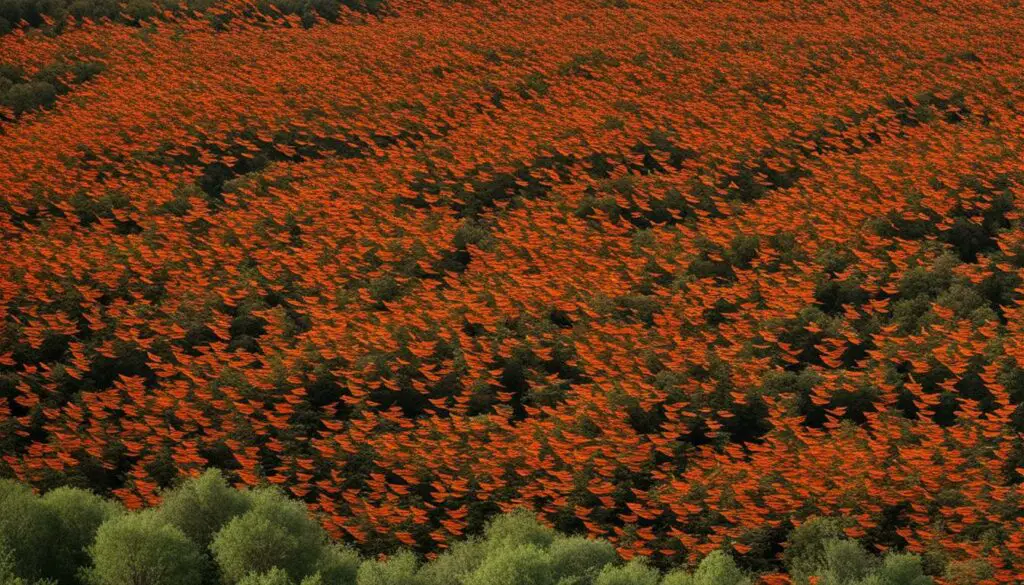
The migration routes and distances of monarch butterflies showcase the extraordinary nature of their journey. By understanding these routes and the challenges they face, we can better appreciate the marvels of their migration and work towards preserving their habitats for future generations to witness this incredible phenomenon.
Monarch Butterfly Migration Season and Behavior
The monarch butterfly migration is not only a remarkable phenomenon in terms of its distance and duration, but also in terms of its timing and behavior. The migration season of monarch butterflies begins in the spring as they make their way north. As the days grow shorter and temperatures start to cool, it signals the end of their northern migration. This change in environmental conditions triggers a unique generation of butterflies to be born.
This special generation, known as the “super generation,” has longer lifespans, can fly further distances, and is responsible for the incredible journey south to Mexico. While the other generations of monarch butterflies complete their journey north, this super generation embarks on a non-stop flight of thousands of miles to reach their overwintering sites in central Mexico. It is truly fascinating how monarch butterflies exhibit a leap-frog behavior, with each generation passing the baton to the next.
Throughout their migration, monarch butterflies display various behaviors that contribute to their successful journey. They rely on a combination of external cues, such as changes in daylight and temperature, as well as internal biological mechanisms to navigate their way. These mechanisms include a sun compass, which helps them determine their direction relative to the sun, and a circannual clock, which helps them track the changing seasons. This intricate combination of behaviors allows monarch butterflies to complete their migration in a synchronized and efficient manner.
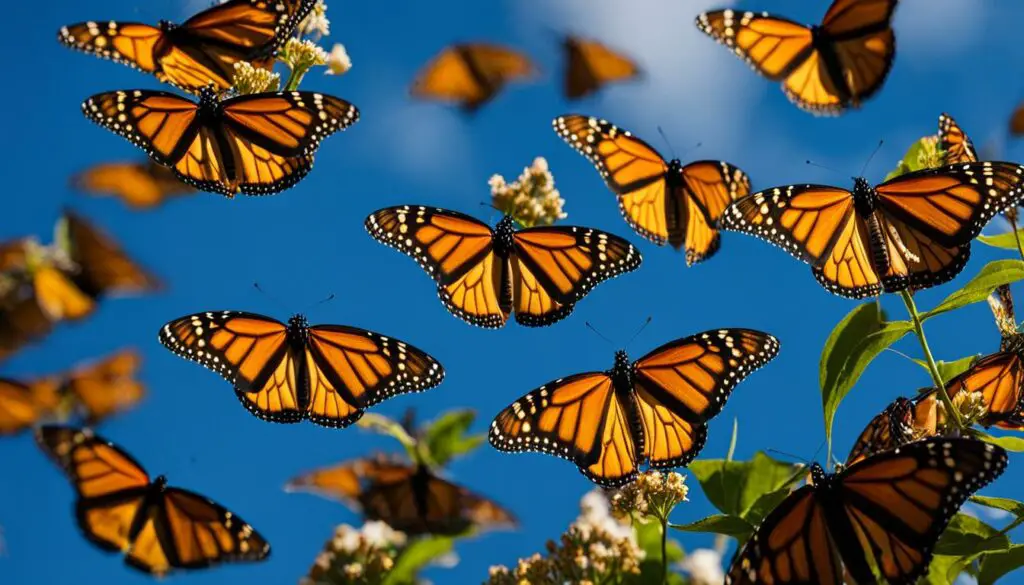
Table: Monarch Butterfly Migration Season and Behavior
| Migration Stage | Behavior |
|---|---|
| Spring | Monarchs start their journey northwards, mating and laying eggs along the way |
| End of Summer | Shorter days and cooler temperatures trigger the birth of the “super generation” |
| Fall | The super generation migrates south to Mexico, while other generations continue their journey north |
As we continue to unravel the mysteries of monarch butterfly migration, we gain a deeper appreciation for the complexity and beauty of this natural phenomenon. Understanding the seasonality and behavior of monarch butterflies during their migration is crucial for their conservation and ensuring the survival of their incredible journey for future generations to witness.
Monarch Butterfly Migration Habitats and Conservation
Monarch butterflies rely on specific habitats throughout their migration, making habitat conservation essential for their survival. These habitats consist of a mix of nectar flowers and native milkweed, which serves as the primary host plant for monarch butterflies. Native milkweed is crucial for their reproduction as it provides the necessary food source for their caterpillars.
However, the availability of milkweed has been declining, posing a serious threat to the monarch butterfly population. Factors such as habitat loss, land-use change, and the use of herbicides and pesticides have contributed to the decline of milkweed. To ensure the conservation of monarch butterflies and their migration, it is important to restore and increase the extent of habitat with appropriate milkweed species and nectar sources.
Individuals can also contribute to the conservation efforts by planting backyard habitats that include milkweed and nectar flowers. By creating suitable environments for monarch butterflies, we can help support their population and ensure their continued migration. Additionally, reducing the use of herbicides and pesticides, as well as addressing issues related to land-use change, is crucial for the conservation of monarch butterflies and their habitats.
| Habitat Conservation Actions | Impact |
|---|---|
| Restoring and increasing milkweed habitats | Provides essential food source and breeding grounds for monarch butterflies |
| Planting backyard habitats with milkweed and nectar flowers | Creates supportive environments for monarch butterflies and supports local populations |
| Reducing the use of herbicides and pesticides | Protects monarch butterflies and other pollinators from negative impacts |
| Addressing land-use change issues | Preserves and protects monarch butterfly habitats from further degradation and loss |
Conserving the habitats of monarch butterflies is crucial for their continued migration and overall population health. By taking action at an individual and collective level, we can help ensure the survival and wonder of these magnificent creatures for generations to come.
Monarch Butterfly Sensitivity to Climate Change
As fascinating as the monarch butterfly migration is, it is important to acknowledge the vulnerability of these magnificent creatures to climate change. Monarchs rely on precise environmental cues, especially temperature, to trigger critical behaviors such as reproduction, migration, and hibernation. Changes in climate patterns, including shifts in temperature and precipitation, can disrupt these cues and impact the population dynamics and habitat suitability for monarch butterflies. Extreme weather events such as droughts and severe storms further exacerbate their vulnerability, potentially causing significant impacts on their survival and reproductive success.
To understand the temperature tolerance of monarch butterflies, scientists have conducted extensive research on the species. Monarchs thrive in a range of temperatures, with the ideal conditions being around 77 to 86 degrees Fahrenheit (25 to 30 degrees Celsius). However, they have been found to tolerate temperatures as low as 45 degrees Fahrenheit (7 degrees Celsius) and as high as 104 degrees Fahrenheit (40 degrees Celsius). This adaptability allows them to occupy a variety of habitats throughout their migration range.
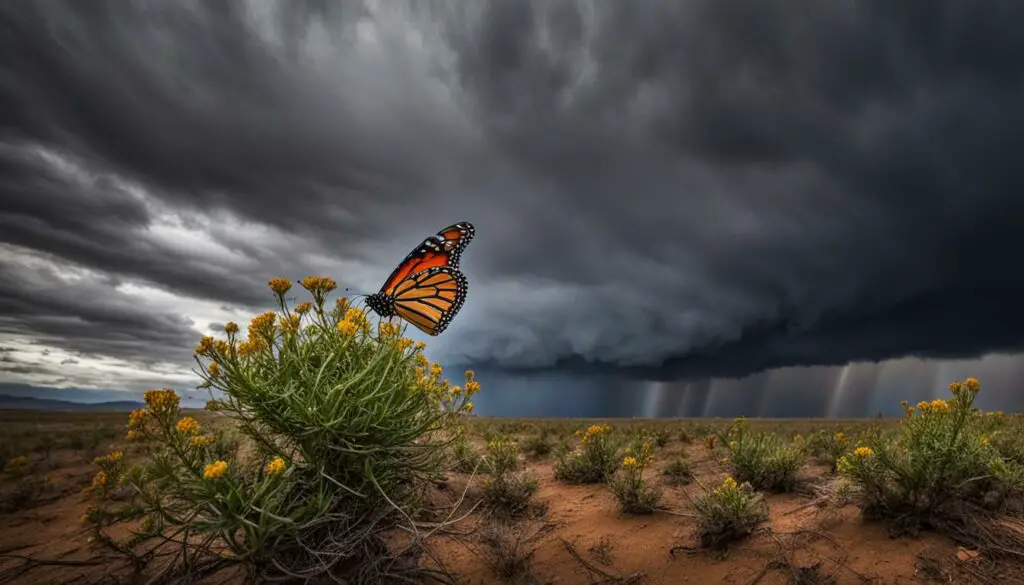
Monarch Butterfly Temperature Tolerance
| Temperature Range (°F) | Temperature Range (°C) | Tolerance Level |
|---|---|---|
| 45 – 86 | 7 – 30 | Optimal Range |
| Below 45 | Below 7 | Moderate Tolerance |
| Above 86 | Above 30 | Moderate Tolerance |
| 104+ | 40+ | Extreme Tolerance |
Table: Monarch Butterfly Temperature Tolerance
The table above summarizes the temperature ranges and the corresponding tolerance levels for monarch butterflies. While they are highly adaptable to various temperature conditions, extreme shifts and prolonged exposure to temperatures outside their optimal range can have significant consequences for their survival and ability to complete their migration. It is crucial to monitor the impact of climate change on monarch butterflies and take proactive measures to mitigate its effects and ensure the long-term resilience of these remarkable creatures.
Monarch Butterfly Adaptive Capacity
Monarch butterflies possess remarkable adaptive traits that allow them to respond to changes in their environment. Their high dispersal ability enables them to travel long distances during migration, playing a crucial role in their survival. Despite having a short generation time and a rapid reproductive rate, monarchs exhibit a surprising capacity to adapt to longer-term changes in climate.
These butterflies rely on a combination of internal biological mechanisms and external environmental cues to guide their migration. Their adept navigation and orientation abilities, such as using the sun compass and circannual clock, contribute to their adaptive capacity. Monarchs can utilize wind currents, barometric pressure, magnetic fields, and surrounding geography to guide their journey with precision.
“Monarch butterflies possess a remarkable capacity for navigation and orientation, using a combination of environmental cues and internal mechanisms to guide their migration.”
Additionally, monarch butterflies exhibit a high level of genetic variation within their populations. This genetic diversity plays a vital role in their ability to adapt to changing environmental conditions. It provides them with the potential for evolutionary responses to different challenges, including shifts in climate patterns.
Overall, the monarch butterfly’s adaptive capacity is a testament to their resilience and ability to thrive in various environments. Their dispersal ability, generation time, navigation skills, and genetic variation all contribute to their remarkable adaptability in the face of changing conditions.
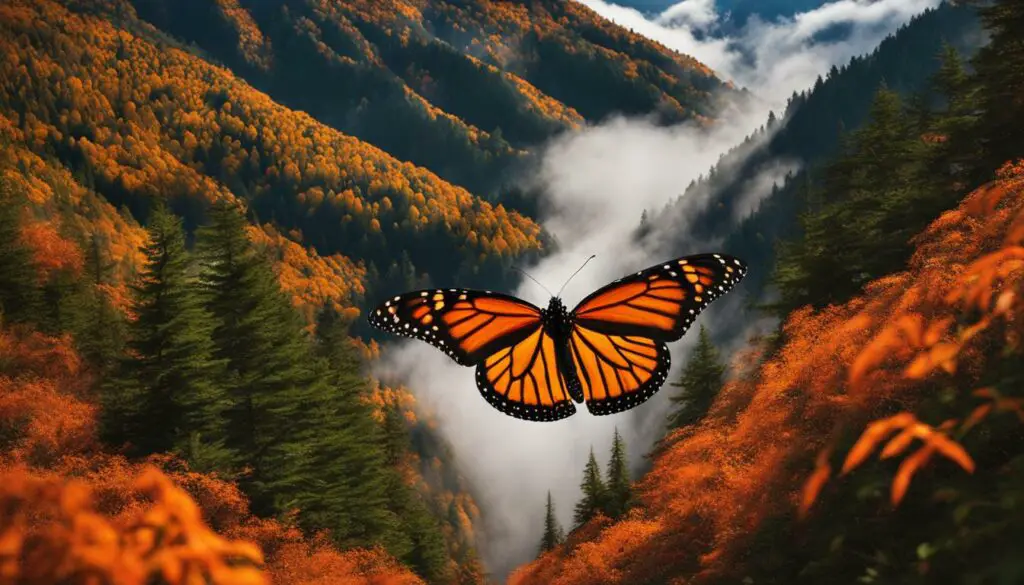
Monarch Butterfly Adaptive Capacity
| Adaptive Traits | Description |
|---|---|
| Dispersal Ability | Monarchs can travel long distances, allowing them to find suitable habitats and adapt to changing conditions. |
| Generation Time | Monarchs have a short generation time, which enables them to produce multiple generations within a single year and respond quickly to environmental changes. |
| Navigation and Orientation | Monarchs possess exceptional navigation and orientation abilities, using the sun compass, circannual clock, wind currents, barometric pressure, and magnetic fields to guide their migration. |
| Genetic Variation | The high genetic diversity within monarch populations provides the potential for evolutionary responses to changing environmental conditions. |
Monarch Butterfly Exposure to Climate Variability
The monarch butterfly population is highly exposed to climate variability, including extreme weather events. These events can have significant impacts on their survival, reproduction, and migration patterns. Floods, droughts, storms, and temperature fluctuations pose challenges to the monarch butterfly population, affecting their abundance and distribution. As climate change intensifies, the frequency and intensity of these extreme events are expected to increase, further exacerbating the vulnerability of monarch butterflies.
In recent years, monarch populations have experienced fluctuations and declines attributed to extreme weather events. Severe storms and droughts can disrupt their breeding habitats, reduce their food sources, and disrupt their migratory pathways. These disruptions can lead to reduced reproductive success and increased mortality rates among monarch butterflies. Additionally, shifts in temperature and precipitation patterns can affect the timing and duration of key life cycle events, such as migration and hibernation.
Understanding the exposure of monarch butterflies to climate variability is crucial for developing effective conservation strategies. By studying their responses to extreme weather events and monitoring changes in their population dynamics, scientists can gain insights into the impacts of climate variability on monarch butterflies. This knowledge can inform conservation efforts, such as habitat restoration and protection, to mitigate the negative effects of climate change on monarch populations.
Impacts of Extreme Weather Events on Monarch Butterflies
The impacts of extreme weather events on monarch butterflies are multifaceted. Floods and severe storms can destroy their breeding habitats and food sources. Heavy rainfall can wash away milkweed plants, which are critical for monarch caterpillar development. Strong winds can disrupt their migration, causing monarchs to be blown off course or encounter challenging conditions during flight. Droughts can lead to the scarcity of nectar flowers, reducing the availability of food for adult monarchs. These disruptions in habitat and food availability can result in reduced reproductive success, lower survival rates, and population declines among monarch butterflies.
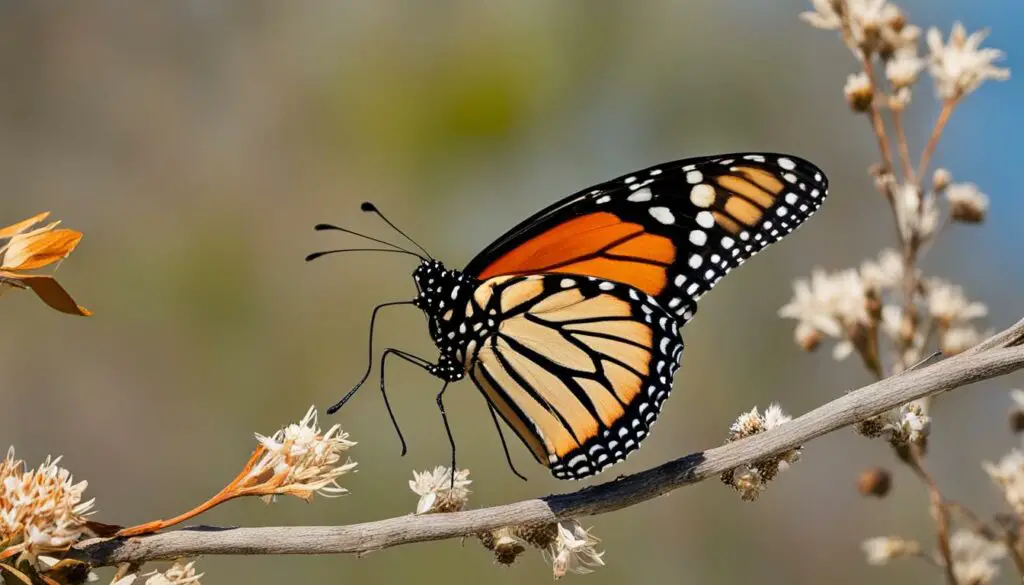
The Importance of Conservation in the Face of Climate Variability
Conservation efforts are vital for ensuring the resilience and long-term survival of monarch butterflies in the face of climate variability. Protecting and restoring their habitats, including the availability of milkweed plants, is crucial for supporting their reproduction and migration. Creating corridors and protected areas can help monarchs navigate through changing landscapes and ensure their access to suitable breeding and feeding grounds. Additionally, promoting sustainable land management practices, reducing pesticide use, and addressing the impacts of climate change at a broader scale are essential for safeguarding monarch butterflies and their migration phenomenon.
Monarch Butterfly Other Threats
While climate change poses a significant challenge to the survival of monarch butterflies, they are also facing other threats that impact their habitat and overall population. Habitat destruction and changes in land management practices are major concerns, as they result in the loss of suitable habitats for monarchs. The destruction of milkweed, their primary host plant, is particularly detrimental to their survival. Pollution, poaching, and human-wildlife conflicts further contribute to the decline in monarch populations.
In order to address these threats and ensure the long-term viability of monarch butterflies, it is vital to implement conservation strategies. This includes restoring and increasing the extent of habitat with appropriate milkweed species and nectar sources. By planting backyard habitats and participating in citizen science monitoring programs, individuals can actively contribute to their conservation efforts. Additionally, reducing the use of herbicides and pesticides, as well as addressing issues related to land-use change, are essential steps towards protecting monarch butterflies.
“The loss of habitat and the decline in milkweed availability pose significant challenges to the survival of monarch butterflies.”
Table: Threats to Monarch Butterfly Population
| Threat | Description |
|---|---|
| Habitat Destruction | Loss of suitable habitats due to urbanization, agriculture, and deforestation. |
| Land-Use Change | Conversion of natural habitats into other land uses, such as commercial or residential areas. |
| Milkweed Loss | Decline in the availability of milkweed, the primary host plant for monarch larvae. |
| Pollution | Contamination of air, water, and soil by chemicals and pollutants, impacting butterfly health. |
| Poaching | Illegal collection of monarch butterflies or their parts, for commercial or personal purposes. |
| Human-Wildlife Conflicts | Interactions between humans and monarchs that result in harm or disturbance to the butterflies. |
Addressing these threats and implementing effective conservation strategies are crucial for ensuring the long-term survival of monarch butterflies and their iconic migration phenomenon. By understanding the challenges they face and taking action to protect their habitats, we can contribute to the preservation of these beautiful insects for future generations.
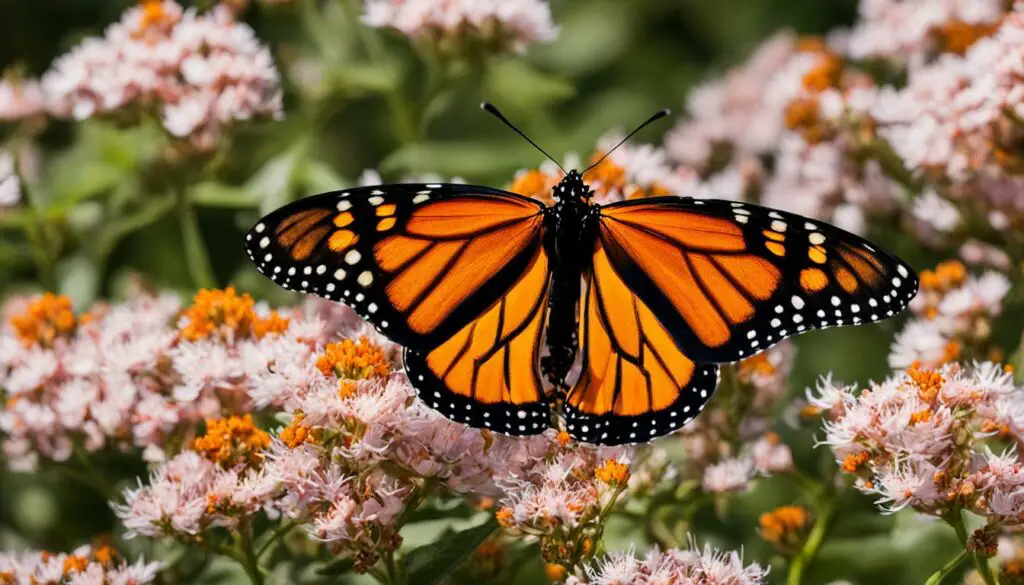
Monarch Butterfly Reproductive Rate and Genetic Variation
The reproductive rate of monarch butterflies is truly remarkable. Female monarchs have the ability to lay hundreds of eggs in their lifetime. However, the survival rate of monarch caterpillars and adults is relatively low, resulting in a high mortality rate. Despite this, monarch populations are able to maintain their numbers through their high reproductive capacity.
Genetic studies have shown that there is gene flow between Eastern and Western populations of monarch butterflies. This means that there is interbreeding between these populations, allowing for the exchange of genetic material. As a result, there is relatively high genetic variation within both the Eastern and Western populations of monarch butterflies.
| Monarch Butterfly Reproductive Rate | Monarch Butterfly Genetic Variation |
|---|---|
| The reproductive rate of female monarch butterflies is high, with the ability to lay hundreds of eggs in their lifetime. | Genetic studies have shown that there is gene flow between Eastern and Western populations of monarch butterflies, resulting in relatively high genetic variation within both populations. |
| However, the mortality rate among monarch caterpillars and adults is also high, resulting in a low survival rate. | Genetic variation is important for the adaptive capacity and resilience of monarch butterflies in the face of changing environmental conditions. |
| High genetic variation allows monarch populations to adapt to new challenges and increases their chances of survival. |
The high reproductive rate and genetic variation of monarch butterflies contribute to their ability to adapt to environmental changes. While individual monarchs may have a short lifespan, their offspring inherit the genetic diversity that allows them to thrive in different conditions. This adaptability is crucial for their long-term survival and resilience in the face of challenges such as climate change and habitat loss.
Monarch Butterfly Life Cycle and Migration Adaptations
The life cycle of monarch butterflies is a fascinating journey filled with remarkable adaptations. This iconic species undergoes a metamorphosis from egg to caterpillar to chrysalis before finally emerging as a beautiful adult butterfly. The entire process, known as the monarch butterfly life cycle, is intricately linked to their migration patterns. Let’s explore the stages of their life cycle and the adaptations that enable them to undertake their incredible journey.
Stage 1: Egg – Female monarch butterflies carefully select milkweed plants as the ideal location to lay their eggs. These tiny, oval-shaped eggs are approximately the size of a pinhead and are attached to the undersides of milkweed leaves. Over the course of a few days, the eggs hatch, revealing small, striped caterpillars.
Stage 2: Caterpillar – The caterpillar phase is characterized by rapid growth and voracious eating. Monarch caterpillars solely feed on milkweed leaves, which contain toxic chemicals that provide them with protection from predators. They go through several molting stages, shedding their old skin as they grow larger. After approximately two weeks, the caterpillar enters its final stage of development.
Stage 3: Chrysalis – The caterpillar attaches itself to a vertical surface, such as a milkweed stem or a leaf, and forms a protective casing called a chrysalis. Inside the chrysalis, dramatic changes occur as the caterpillar transforms into a butterfly. This process, known as metamorphosis, takes about 10 days to complete. Finally, the chrysalis splits open, and the adult monarch butterfly emerges.
Stage 4: Adult Butterfly – The newly emerged butterfly, with its vibrant orange and black wings, is now ready for its extraordinary migration journey. During migration, monarch butterflies exhibit incredible adaptations that enable them to navigate vast distances. They use a combination of environmental cues, such as temperature, daylight, wind currents, and even the Earth’s magnetic field to guide their flight. These remarkable adaptations allow them to complete their migration and reach their overwintering sites in Mexico or California.
Understanding the life cycle and migration adaptations of monarch butterflies provides us with a deeper appreciation for the marvels of the natural world. Their incredible transformations and adaptive behaviors highlight the importance of conserving their habitats and ensuring their survival for future generations to witness. Through conservation efforts and public awareness, we can contribute to the preservation of this awe-inspiring species.
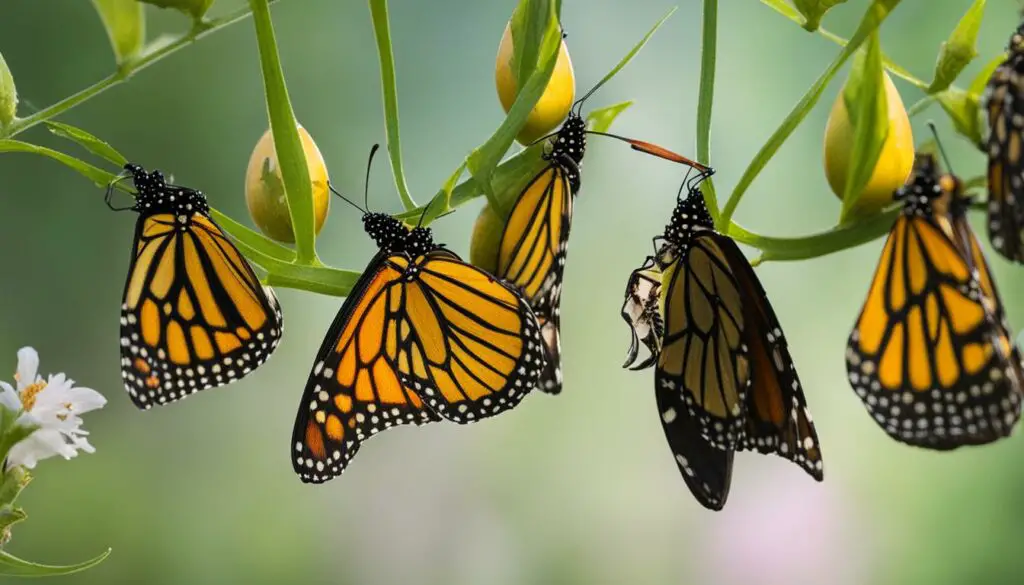
Monarch Butterfly Life Cycle
| Stage | Description |
|---|---|
| Egg | Tiny, oval-shaped eggs laid on milkweed leaves |
| Caterpillar | Rapidly growing caterpillar that feeds on milkweed leaves |
| Chrysalis | Protective casing where the caterpillar undergoes metamorphosis |
| Adult Butterfly | The fully developed butterfly ready for migration |
Monarch Butterfly Navigation and Orientation
The monarch butterfly’s ability to navigate and orient itself during its incredible migration journey is a subject of ongoing research and fascination. These tiny insects rely on a combination of environmental cues and internal mechanisms to guide them on their long-distance flights.
One of the key navigation tools used by monarch butterflies is the time-compensated sun compass. This remarkable internal compass enables them to determine their direction relative to the position of the sun. By combining the sun’s position with their internal clock located in their antennae, monarchs can accurately guide themselves southwest during migration. It’s as if they have a built-in GPS system that steers them towards their destination.
Monarch butterflies also utilize a range of other cues to aid their navigation and orientation. They can sense wind currents, barometric pressure, and even magnetic fields. These elements help them adjust their flight path and maintain a steady course towards their overwintering sites. Additionally, monarchs are believed to have a spatial memory that allows them to recognize and remember landmarks along their migratory route.
It’s truly remarkable how monarch butterflies, with their limited neural resources, can employ such sophisticated navigation strategies. These mechanisms, combined with their high dispersal ability and short generation time, contribute to their adaptive capacity and allow them to respond to changes in their environment. Understanding the intricacies of monarch butterfly navigation is not only a scientific marvel but also crucial for their conservation and continued survival.
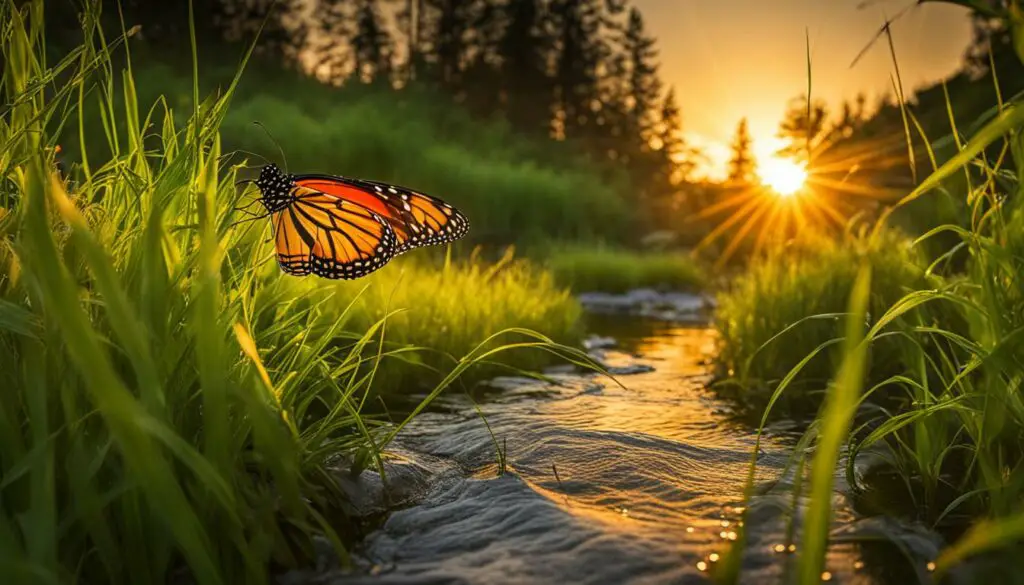
Monarch Butterfly Conservation Efforts
Conservation efforts are paramount in ensuring the survival of the iconic monarch butterflies and their remarkable migration phenomenon. Various strategies are being implemented to protect these magnificent creatures and the habitats they rely on.
Restoring Habitat and Increasing Milkweed
One of the key focuses of monarch butterfly conservation is restoring and increasing the extent of suitable habitat. This involves planting native milkweed species, which is crucial for the survival and reproduction of monarchs. By providing an abundance of milkweed and nectar sources in both natural and urban landscapes, we can create vital stepping stones along their migration routes and support their populations.
Reducing Herbicide and Pesticide Use
The use of herbicides and pesticides has a detrimental impact on monarch butterflies. These chemicals not only kill milkweed, but also harm the adult butterflies and their caterpillars. By reducing the use of these harmful substances and adopting alternative pest control methods, we can create safer environments for monarchs and other beneficial insects.
Citizen Science and Population Monitoring
Citizen science plays a crucial role in monarch butterfly conservation. Many organizations and individuals actively contribute to population monitoring programs, providing valuable data on butterfly sightings, migration patterns, and habitat conditions. This data helps researchers and conservationists identify trends, assess population health, and make informed decisions regarding conservation strategies.
| Conservation Efforts | Description |
|---|---|
| Habitat Restoration | Restoring and increasing suitable habitat with native milkweed species. |
| Reducing Chemical Use | Minimizing the use of herbicides and pesticides in monarch habitats. |
| Citizen Science | Engaging the public in data collection and population monitoring programs. |
Through collaborative efforts and individual actions, we have the power to protect and preserve the monarch butterfly migration phenomenon for future generations. By fostering a deep appreciation for these magnificent creatures and the ecosystems they inhabit, we can drive positive change and secure a brighter future for monarch butterflies.
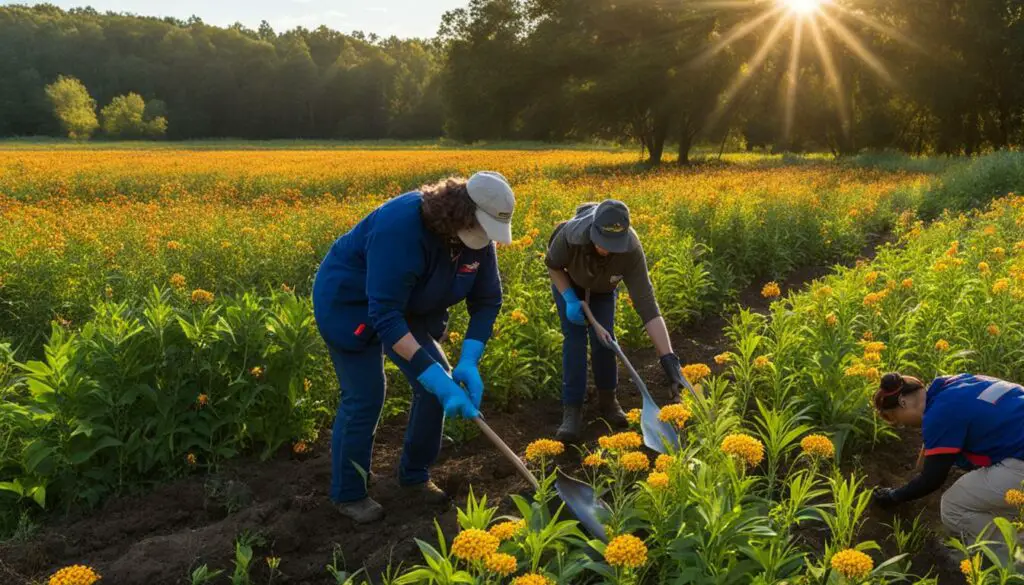
Monarch Butterfly Migration Phenomenon
The migration of monarch butterflies is a truly mesmerizing phenomenon that captivates both scientists and the public alike. These delicate insects undertake an extraordinary journey that spans thousands of miles and multiple generations. From North America to Mexico and back, monarch butterflies demonstrate their remarkable ability to navigate with precision, relying on limited neural resources and environmental cues.
The monarch butterfly migration is a marvel of nature, highlighting the intricate adaptations and behaviors of these small creatures. They follow specific migration routes, ensuring they reach their designated overwintering sites in central Mexico or the California coast. The distance covered by monarch butterflies during their migration is awe-inspiring, with some individuals traveling up to 4,500 km each way.
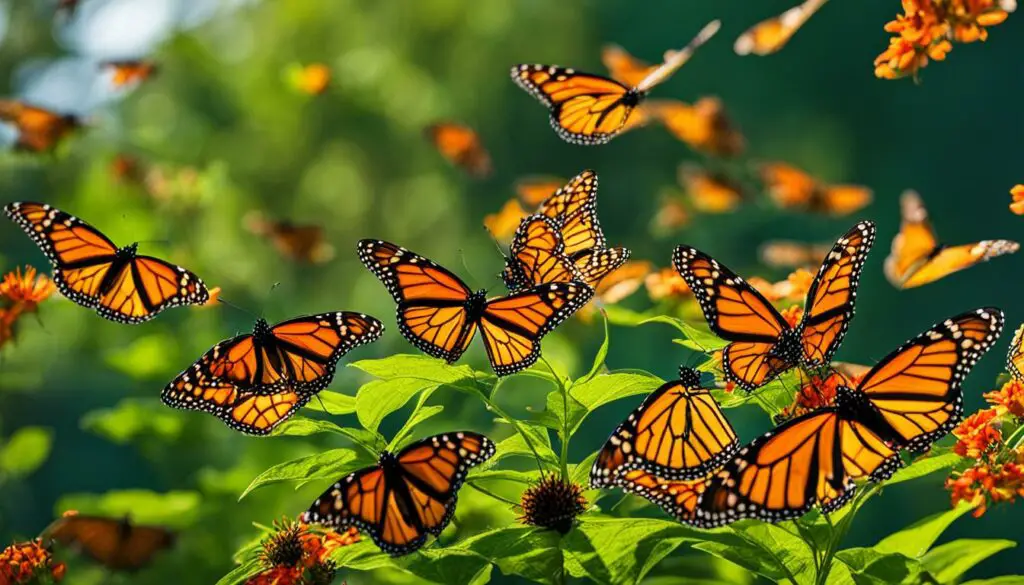
Throughout their migration, monarch butterflies face numerous challenges, including habitat loss, climate change, and other human impacts. Conservation efforts are crucial for preserving this magnificent migration phenomenon. By understanding and appreciating the intricacies of their journey, we can work together to ensure the survival of these iconic butterflies for future generations to witness and marvel at.
Conclusion
In conclusion, the monarch butterfly migration is a truly remarkable phenomenon in the natural world. These small insects embark on an incredible journey each year, traveling thousands of miles from North America to Mexico and back. Their migration patterns and behaviors are similar to those of birds, as multiple generations of butterflies complete the journey, passing the baton from one to the next.
Throughout their migration, monarch butterflies rely on specific routes and habitats, requiring a mix of nectar flowers and native milkweed as their primary host plant. However, the availability of milkweed is declining, posing a threat to their population. Climate change further exacerbates their vulnerability, as monarchs rely on temperature cues to trigger key behaviors. Extreme weather events and shifts in temperature and precipitation patterns can have significant impacts on their survival and reproductive success.
Conservation efforts are essential to ensure the long-term viability of monarch butterflies and their migration. By restoring and increasing suitable habitat, reducing the use of harmful chemicals, and addressing issues related to land-use change, we can contribute to their conservation. Engaging the public in planting backyard habitats and participating in citizen science programs is also crucial. By understanding and appreciating the wonders of the monarch butterfly migration, we can work together to preserve this marvel of nature for future generations.
FAQ
What is the Monarch butterfly migration?
The Monarch butterfly migration refers to the remarkable journey tens of millions of Monarch butterflies undertake each winter from North America to central Mexico.
How far do Monarch butterflies travel during migration?
Monarch butterflies can cover distances of up to 4,500 km each way during their migration.
How many generations of Monarch butterflies complete the migration?
It takes multiple generations of Monarch butterflies to complete the migration. Each generation passes the baton to the next as they fly, mate, lay eggs, and die.
What routes do Monarch butterflies follow during migration?
The eastern population of Monarch butterflies migrates up to 3,000 miles from northern parts of North America to central Mexico, while the western population overwinters on the California coast.
When does the Monarch butterfly migration season start?
The Monarch butterfly migration season starts in spring as the butterflies make their way north. The fading light of summer marks the end of their northern migration.
What triggers the southward migration of Monarch butterflies?
Shorter days and cooler temperatures trigger a special generation of eggs to be laid by female Monarch butterflies. These eggs hatch into caterpillars that become part of the “super generation” that migrates south to Mexico.
What habitats do Monarch butterflies need during migration?
Monarch butterflies require a mix of nectar flowers and native milkweed as their primary host plant. The availability of milkweed is crucial for their survival and reproduction.
How can I contribute to the conservation of Monarch butterflies?
You can contribute to the conservation of Monarch butterflies by planting backyard habitats with milkweed and nectar sources. Additionally, reducing the use of herbicides and pesticides and addressing issues related to land-use change is essential.
How are Monarch butterflies affected by climate change?
Monarch butterflies are highly sensitive to weather and climate, and changes in temperature and precipitation patterns can impact their population dynamics and habitat suitability.
What adaptive traits do Monarch butterflies possess?
Monarch butterflies have a high dispersal ability, a short generation time, and a high reproductive rate, which contribute to their adaptive capacity in the face of changing environmental conditions.
What threats do Monarch butterflies face apart from climate change?
Monarch butterflies face threats such as habitat destruction, changes in land management practices, pollution, poaching, and human-wildlife conflicts.
How does Monarch butterfly navigation and orientation work?
Monarch butterflies use a combination of environmental cues such as the sun compass, circannual clock, wind currents, barometric pressure, magnetic fields, and surrounding geography to navigate their migration.
How can I get involved in Monarch butterfly conservation efforts?
You can get involved in Monarch butterfly conservation efforts by participating in citizen science monitoring programs and supporting conservation organizations. Planting milkweed and creating suitable habitats is also a valuable contribution.
Why is the Monarch butterfly migration phenomenon important?
The Monarch butterfly migration phenomenon is important as it highlights the wonders of the natural world and the need for conservation efforts to ensure the survival of these iconic butterflies for future generations.

